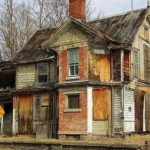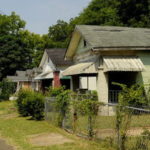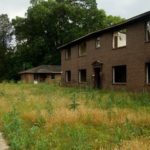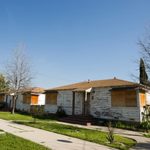When I travelled north on the train towards DC, I was shocked by the number of dilapidated houses I could see, especially south of Birmingham. On that trip, a lady mentioned that it might be leftover Hurricane Katrina damage. Heading south this time, I paid closer attention and decided it couldn’t be hurricane damage, it just did not have that feel. House’s were not flattened and torn to little bits like a hurricane or tornado would do. They were decayed and/or burned out abandoned house carcasses, left to rot in the elements.
Amtrak has Wi-Fi that sometimes works and when I could, I did some research. First, I was not surprised to learn that the worst swath of Hurricane Katrina, the part with the highest winds, did not get all the way up Birmingham, which is decidedly inland. Second, it turns out that Birmingham has a “blight” problem. Many inner-city or nearby neighborhoods have, indeed been abandoned.
The problem began in the Civil Rights era, 50 years ago. Whites owned the homes but then fled to the suburbs during the “white flight” days of the 60s and 70s. Black families moved in but the next generations moved on when manufacturing jobs fizzled away. People could not sell the homes and often just left them. This in turn caused a huge problem for the city because the titles to abandoned homes with tax liens cause nightmares for years and legions of attorneys to unravel. Besides, the city didn’t allocate funds for blight removal, so the homes continued to decay. In the meantime, the city spends $6.6 million–13 percent of the public works budget–just cutting the grass.
From a local news source:
“John Colón is the director of the Department of Community Development. He says change starts with the city getting rid of abandoned structures. According Colón, Birmingham currently has over 16,000 deserted, tax-delinquent properties. Colón says the sheer magnitude of the problem is unique. “I think it’s important to note that we’re attempting to do in Birmingham is unlike anything that’s been done in the country,” he says. “And possible has never been a part of the discussion; we’re saying we don’t have a choice, our city is under siege right now.”
Funny that Colon says the city is under siege. The areas that I saw from the trains do look war-torn.
From Alabama.com:
“A burned-out husk has loomed behind John Harris’ home in North Titusville for years, its once-red condemnation notice faded to brown. Police recently found the body of a heroin addict inside, but Harris doesn’t think the city will do anything about it.
“They just left us to die on the vine,” he says.
The retired postman has spent years as neighborhood president pushing Birmingham City Hall to demolish ruins like this. North Titusville is teeming with blighted properties, some empty and overgrown, others burned or looted. Some are simply sagging down, slowly, like rotten jack-o’-lantern.
Thankfully, the City is now allocating millions ($6..5 in 2016) to demolish the buildings. The hope for the future is that people will buy up lots at below market prices and build nice homes there again. With the trend towards urban living and lofts, I imagine this would be highly successful. Of course, the City must also run off drug peddlers and prostitutes who sometimes set up shop in the buildings.
Also from Alabama. com:
“A half century of population loss has made dead and dying housing complexes a regular feature of Birmingham’s residential areas. They poison property values, attract crime, squatters and vermin, and may be one of the greatest obstacles for Birmingham’s ongoing efforts at urban renewal.”
I have heard the term “urban renewal” over the last 50 years and even observed it in the city where I grew up. When I was in Akron last summer, I saw a formerly rundown area in downtown that city folks developed into a jazz district. Other cities are tackling the same issues and perhaps could be an example for Birmingham. The Washington Post looked at the problem and reported on some strategies used by other cities:
“Cities from Detroit to Philadelphia, though, are increasingly finding novel techniques to fight back. Detroit deployed more than 150 residents, survey software in hand, to document the most extensive census of vacant landthat has ever been conducted in a U.S. city. Now the land bank in Detroit is trying to strategically auction abandoned homes worth salvaging, as the city prioritizes neighborhoods with the best chance of recovery.
Chicago has been offering up empty lots for a single dollar to nearby residents and organizations who will care for them (and pay their property taxes). Jacksonville, Fla., passed a new ordinance allowing the city to demolish abandoned homes. Other cities have discovered that a few minor improvements — replacing plywood over windows with plexiglass, requiring owners to at least install new doors — can transform the look of an empty home. And Philadelphia has proven that even a little light landscaping on vacant lots — at the cost of maybe $1,000 a parcel — can significantly curb gun crime, boost property values and even aid residents’ health.”
No doubt that investors and entrepreneurs will transform Birmingham and other cities. An example I read about a few years ago is a soap-making company, Method. They built their business in a blighted area of Chicago and brought jobs to the locals.
We also need this space for urban housing. I have thought that to conserve more land we need to be building tall, multi family dwellings and stop tearing down our forests and ripping up farmland. Urban renewal holds a lot of promise on many fronts. We have squandered so many billions on useless wars. We need the money here for our cities and our people. Cleaning up urban blight would truly be a step towards making America great again.








